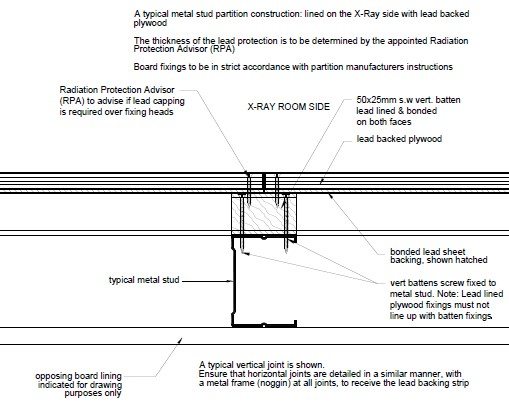An overview of Frequently Asked Questions from our Ionising Radiation Shielding CPDs
As experts in radiation shielding, Midland Lead has introduced a RIBA-approved CPD for architects and specifiers: “Ionising Radiation Shielding: Principles and Practice in Healthcare” this year. Now we’ve held over 10 of these training modules, Warren Goodall, our Healthcare Business Development Manager looks back and discusses our most frequently asked questions and answers…
Question 1: How do materials ‘absorb’ radiation?
Answer: X-ray and gamma radiation are best absorbed by atoms with heavy nuclei; the heavier the nucleus, the greater the absorption.
Lead’s high density is caused by the combination of its high atomic mass and the relatively small size of its bond lengths and atomic radius. The high atomic mass means that more electrons are needed to maintain a neutral charge. Whilst the small bond lengths and small atomic radius allows for more atoms to be packed into the lead structure. It is lead’s density and large number of electrons, which make it particularly suited to scattering x-rays and gamma-rays. These rays from photons, a type of boson, impart energy onto electrons upon contact. When the radiation attempts to pass through lead, its electrons absorb and scatter the energy.
In some special applications, depleted uranium or thorium are used, as well as barium sulphate. In fact, almost any material can be used providing it is applied at an appropriate depth or thickness. Lead, however, is usually the most common application as it offers greater protection at far reduced levels of thickness.
Most nuclear reactors use thick concrete to create a bio shield with a thin water cooled layer of lead which protects the porous concrete from the coolant inside. The concrete is also made with heavy, high density aggregates, such as baryte or magnetite, to improve the shielding properties of the concrete.
Question 2: Is it necessary to shield the gap between the door leaf and the floor?
Answer: This will depend on the situation, the type of room, the power of the equipment and the position of the equipment.
Generally, most x-ray rooms have a 10mm gap under the doors. This is regarded as acceptable as the scattered photon energy levels at this point are lower and will be absorbed by the floor. We usually see a gap of 10mm specified by the Radiation Protection Advisor (RPA) and very rarely see instances of this being less. We can manufacture doors if a lower gap is specified e.g. 3mm, however onsite installation may become more difficult. The RPA will stipulate what shielding is needed and at that point we can discuss how to achieve the requirement.
Question 3: Is it necessary to shield the lead-lined board fixings?
Answer: No, if the Radiation Protection Advisor has specified a lead equivalence thickness of less than 3mm. However, fixing shielding will be required if 3mm or above has been specified. The reason for this is that the length of the fixing together with the interference of the helix on the fixing result in a level of attenuation (loss of intensity). Where 3mm or above has been specified then interruption of the photon path by material equivalent to the specified thickness is necessary. This can be done by ‘capping’ the heads of the fixings with the requisite lead thickness or the use of lead battens with lead on both sides. (See Fig. 1)
As always situation specific advice should be sought from a suitably experienced Radiation Protection Advisor.

Question 4: Will lead glass shield laser as well as well as x-rays and gamma rays?
Answer: In short, no. Lead is used in glass @ ~65% to shield against x and gamma ray radiation. Lasers due to their variability require specific shielding and lead is not usually part of the shielding medium. More typically copper, erbium, ytterbium and praseodymium are used in the glass matrix. Alternatively, a film can be introduced onto the lead glass to filter the laser wavelengths. Specific advice should be sought from a suitably qualified Laser Protection Advisor.
Question 5: Are x and gamma rays reflected and refracted when interacting with matter?
Answer: Using the definition that reflection is the throwing back by a body or surface of light, heat, or sound without absorbing it, most interactions by x and gamma ray photons with matter involve a degree of absorption. At low energies, <30 KeV, x and gamma rays (photons) show a degree of scattering of the photons in all directions. However, the direction of travel of the resultant photon is unpredictable. This is unlike reflection and refraction in other mediums and energies in which it is possible to predict. However, using materials with a defined crystal structure it is possible to manufacture mirrors and refractors. The mirrors can be made of glass, ceramic or metal foil, coated by a reflective layer. The most commonly used reflective materials for X-ray mirrors are gold and iridium. Even with these materials, the critical reflection angle is energy dependent. For example, for gold at 1 keV, the critical reflection angle is 2.4 degrees. Silicon crystals have been used for refraction work. These are designed to have specific distances between the molecules with the lattice precisely engineered.
Question 6: Penetrations are always difficult, so how are they treated to adequately shield the x-ray and gamma rays?
Answer: There a number of methods of dealing with penetrations through shielding in healthcare work.
The first is to design the room and the M&E to minimise the need for the shielding in the first place. For example, this can be done by using the gantry on a CT machine as a shield itself.
Unavoidable penetrations will require shielding. This can be achieved by moulding lead around the ducting itself and returning the lead onto the wall for at last 25mm. The distance that the lead will need to come out from the wall is dependent on the photon scatter pattern, the energies involved and the specific room geometry. The Radiation Protection Advisor (RPA) will advise on this.
Where, due to the number and/or geometry of the penetrations, wrapping lead around the penetration is not possible then the introduction of a lead and plywood baffle in a location that will interrupt the shine lines can work well. This should be placed above the finished ceiling height and be of a size and location determined by the RPA.
Question 7: Where do the lead codes for thickness 3 – 8 originate?
Answer: The lead codes were introduced when building went metric back in 1971 with the introduction of SI units (System International). Lead before that date was sold in LBS/ Sq. foot e.g. 4 pounds / sq. foot. A bit hard to convert? The solution – just call it Code 4.
BOOK A CPD FOR YOUR PRACTICE
Interested in organising an Ionising Radiation Shielding CPD for your practice? Simply get in touch with us online and let us know you’re interested. A member of our Healthcare team will get in touch and organise a CPD for you.



